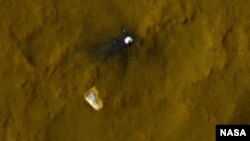The parachute that helped NASA’s Curiosity rover land safely on Mars August 5, 2012 has been spotted flapping in the Martian winds.
The U.S. space agency released a series of seven images taken by the Mars Reconnaissance Orbiter that show how the parachute has shifted positions on the ground over several months. The images were taken between August 12, 2012 and January 13, 2013.
This sequence of seven images from the HiRISE camera on NASA's Mars Reconnaissance Orbiter shows wind-caused changes in the parachute of NASA's Mars Science Laboratory spacecraft as the chute lay on the Martian soil.
The parachute is the largest ever used for a Mars landing with a diameter of 15 meters when fully open. A photo of the parachute fully inflated is available here, and you can see the opened chute during the actual descent to Mars here. A color image of the parachute on the Martian ground is here.
NASA scientists believe the movement of the parachute in the wind may knock off any dust that may have accumulated on it, keeping the parachute bright and visible. For example, the parachute that helped safely land Viking 1, which landed on Mars in 1976, is still visible.
According to NASA, the Viking probes clocked the Martian winds at up to 30 meters per second, strong enough to create massive dust storms that can cover much of the planet. However, more recent observations indicate fewer dust storms, which may show the winds on Mars are slowing. The planet is believed to be getting colder.
Curiosity landed on Mars on a mission to investigate whether the planet ever offered an environment that could have supported microbial life.
The U.S. space agency released a series of seven images taken by the Mars Reconnaissance Orbiter that show how the parachute has shifted positions on the ground over several months. The images were taken between August 12, 2012 and January 13, 2013.
NASA's High Resolution Imaging Science Experiment
This sequence of seven images from the HiRISE camera on NASA's Mars Reconnaissance Orbiter shows wind-caused changes in the parachute of NASA's Mars Science Laboratory spacecraft as the chute lay on the Martian soil.
NASA scientists believe the movement of the parachute in the wind may knock off any dust that may have accumulated on it, keeping the parachute bright and visible. For example, the parachute that helped safely land Viking 1, which landed on Mars in 1976, is still visible.
According to NASA, the Viking probes clocked the Martian winds at up to 30 meters per second, strong enough to create massive dust storms that can cover much of the planet. However, more recent observations indicate fewer dust storms, which may show the winds on Mars are slowing. The planet is believed to be getting colder.
Curiosity landed on Mars on a mission to investigate whether the planet ever offered an environment that could have supported microbial life.












